|
Carnivorous Plant Newsletter
Volume 44, Number 3, September 2015, pages 156 - 163
New Cultivars
Sarracenia ‘Metallized’
Sarracenia ‘Cooke’s Bayou Red’
Sarracenia ‘Elvis Presley’
Sarracenia ‘Amphibien’
Sarracenia ‘Rubis Rare’
Sarracenia ‘Dantadelle’
Sarracenia ‘Metallized’
Submitted: 16 April 2015
Sarracenia ‘Metallized’ germinated in spring 2010 as a seedling in the middle of the mature red S. flava group I have in my greenhouse. The parentage of the plant is unknown. Maybe a seed fell during the seed collection in the autumn or maybe the result of a casual pollination event.
In spring 2014, the tallest pitcher was 76 cm tall (Fig. 1). At that time, the plant was still immature, since it had not yet flowered.
The pitcher color from early spring to late summer, if kept in full sunlight, is a flat and uniform red to dark red from the pitcher top to the rhizome (Figs. 1 & 2). There are no veins or color shades, with the exception of the lid where some pale veins are visible if seen against the light. The edge of the pitcher opening is irregular and angular. In autumn, some smaller pale red/pink pitchers are produced.
In spring 2015, the plant produced an 85-cm-tall flower stem with a pale red flower seen from above and yellow inside seen from below (Fig. 3). The pitchers seem to grow shorter if the plant is allowed to flower. It is possible that a mature plant could be taller than 76 cm if the flower is removed.
The name ‘Metallized’ has been chosen because the presence of vegetal waxes inside the pitcher and the absence of pubescence give to the leaves a particular metallic iridescent appearance if observed in full sun. The nuances that are seen by moving the leaves in the sun are difficult to reproduce photographically, as with the iridescence of sundews.
To preserve the unique features of this cultivar, propagation must be vegetative only.
— Daniele Righetti • 20127 Milano • Italy • flava-rugelii@hotmail.it

Figure 1: In spring 2014, the tallest pitcher of Sarracenia ‘Metallized’ was 76 cm.
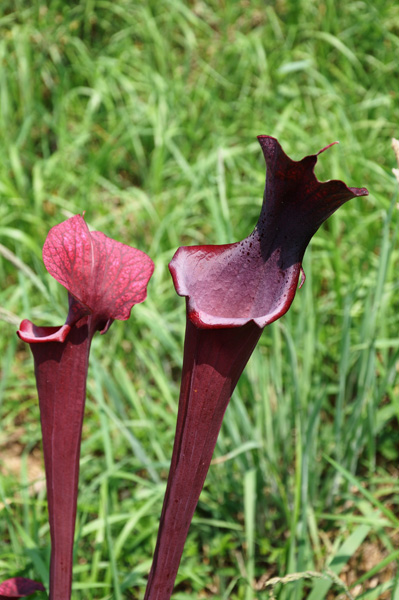 
Figure 2: The pitchers of Sarracenia ‘Metallized’ are dark red with an irregular and angular opening.
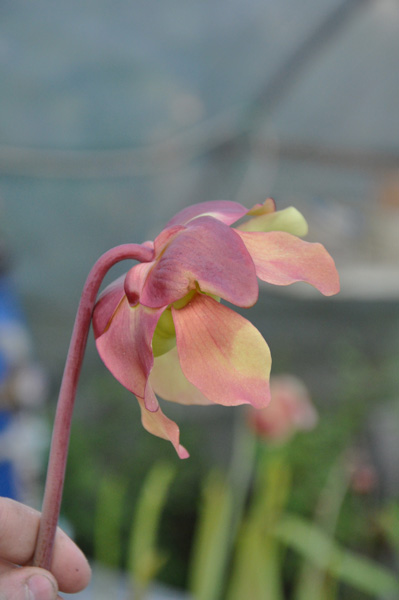 
Figure 3: The flower of Sarracenia ‘Metallized’ is pale red when seen from above and yellow inside from below.
Sarracenia ‘Cooke’s Bayou Red’
Submitted: 10 June 2015
This new cultivar of Sarracenia flava was collected by John Hummer in June 1988 from Bay County, Florida (the site no longer extant, having been converted to a housing development about 20 years ago). The plant has entirely maroon-red pitchers top-to-bottom, and is also unique in having flower petals that are pink-red in color (Fig. 4). The distinct maroon red color spectrum of the leaves along with the unique flower petal color combination should be sufficient to distinguish this once naturally occurring S. flava variant from others in the field. The images explain this form better than words can describe.
— John Hummer • Ruther Glen • Virginia • USA • john4nature@gmail.com
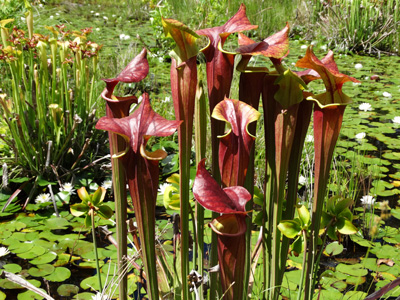 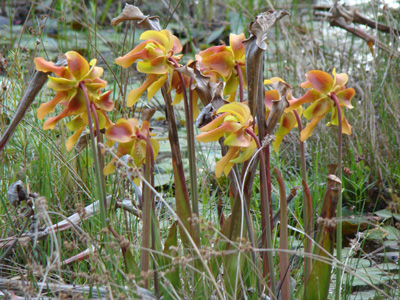
Figure 4: Sarracenia ‘Cooke’s Bayou Red’ maroon-red pitchers (left) and its pinkish-red flowers (right).
Sarracenia ‘Elvis Presley’
Submitted: 28 April 2015
I obtained this hybrid from a French carnivorous plant specialist called “Damien Chertier” who used to sell carnivorous plants. He didn’t remember the origin of the parents.
Sarracenia ‘Elvis Presley’ is a green yellowish plant wearing delicate red veins on glabrous pitchers at the beginning of the growth season, which become finely pubescent at the end of it (Fig. 5). The pale yellow flower that blooms in spring is a little bit taller than the pitchers and is difficult to pollinate. Indeed, I have almost never obtained seeds from this hybrid, or only a few sterile ones. Just before winter, the plant produces some curved phyllodes toward the ground which could suggest Sarracenia oreophila heritage. It grows fast and multiplies easily.
The specific name “Elvis Presley” comes from the particular shape of the lid with its wound spur, which reminds me the hairstyle of the famous rock ’n’ roll singer Elvis Presley.
This hybrid may be the result of complex crossing between Sarracenia oreophila, S. flava, and S. alata. This plant should be reproduced only by vegetative means to ensure that its unique characteristics are maintained.
— Arthur Sanguet • 73000 Chambéry • France • arthur.sanguet@gmail.com
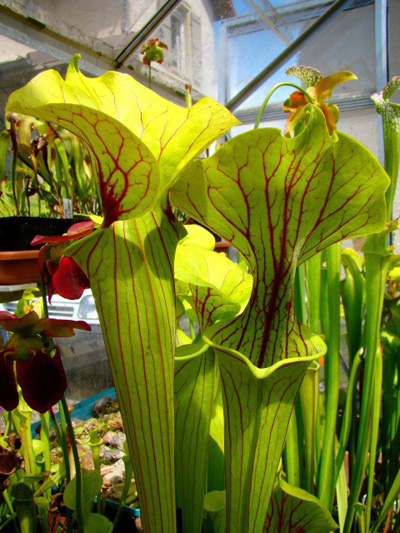 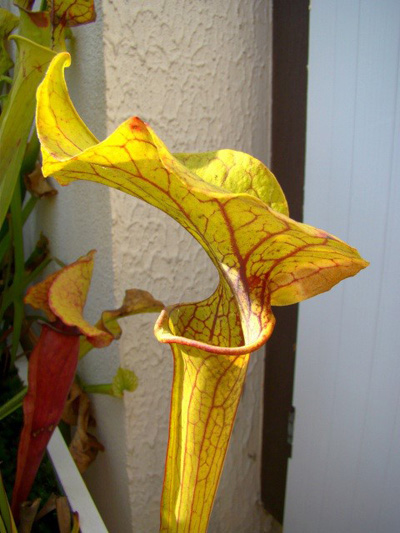
Figure 5: Fresh new veined pitchers of Sarracenia ‘Elvis Presley’ (left) and the peculiar shape of the pitcher lid at the end of the growth season reminds the hair style of Elvis Presley (right).
Sarracenia ‘Amphibien’
Submitted: 28 April 2015
I bought this cute hybrid in 2006 from a French carnivorous plant specialist called “Damien Chertier” who used to sell plants. The parents are unknown.
This little Sarracenia, which rarely exceeds 35 cm in height, possesses red-veined yellowish pitchers at opening, which become all red very fast (Figs. 6 & 7), arranged in a rosette around the rhizome. The small flower with red-to-purple petals and sepals is borne on a peduncle 45 cm high (Fig. 7). The plant produces a lot of pitchers during the growth season but seems to divide very little, usually once a year during spring.
Sarracenia ‘Amphibien’ may be the result of a very complex crossing between Sarracenia psittacina, S. purpurea, and S. alata, but it is still unclear as the shape of the pitchers is very different from other hybrids.
The name “Amphibien” (amphibian in English) comes from the particular shape of the opening pitcher that reminds me a croaking frog. This plant should be reproduced only by vegetative means to ensure that its unique characteristics are maintained.
— Arthur Sanguet • 73000 Chambéry • France • arthur.sanguet@gmail.com
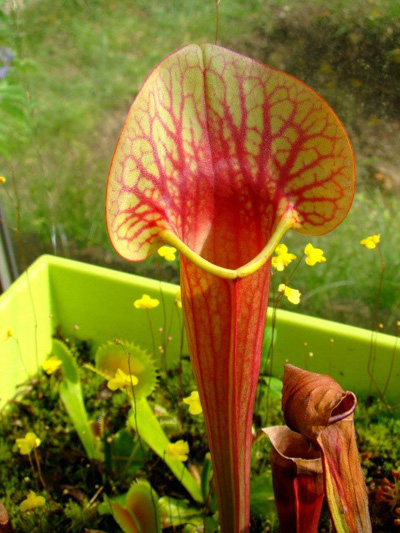 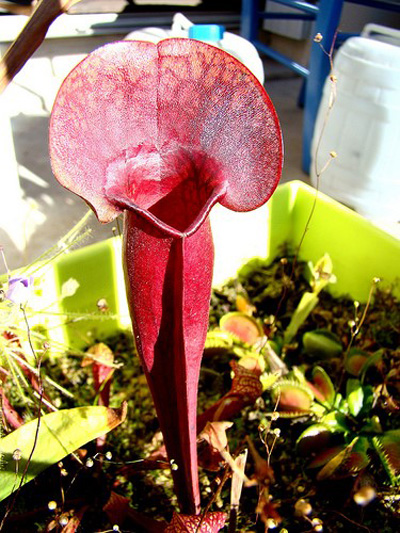
Figure 6: Fresh new pitcher of Sarracenia ‘Amphibien’ (left) and an older pitcher showing pure red coloration (right).
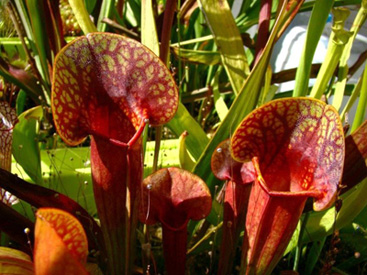 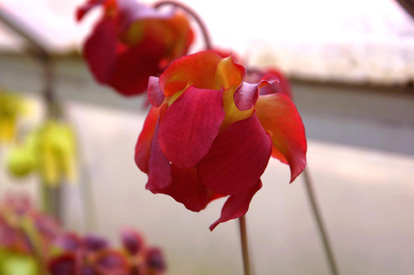
Figure 7: Two pitchers of Sarracenia ‘Amphibien’ in the middle of the growth season (left) and its flowers (right).
Sarracenia ‘Rubis Rare’
Submitted: 28 April 2015
I found this plant in Marcel Lecoulfe’s greenhouse in 2005 without a label. The seller told me it was a special variety of Sarracenia rubra, which is impossible given the shape and color of the pitchers and the flowers.
The plant is 60 cm tall bearing initially orange pitchers which quickly turn red, copper, and purple (Figs. 8 & 9). The underside of the lid is pubescent. The flower is large, with bright yellow bracts and sepals (Fig. 9) that tend to become copper as the season progresses. The first spring pitchers are usually aborted, very small and broadly winged, but they become better shaped during the summer. This plant doesn’t produce a lot of well-formed pitchers.
I called this plant “Rubis Rare” (rare ruby) because of the completely red to purple color of the few pitchers at the end of the growth season.
This hybrid is probably complex, but has certain characteristics of S. purpurea. Nevertheless, its yellow flower and red pitchers indicate a probable crossing with S. flava var. rubricorpora or var. atropurpurea or with S. alata var. nigropurpurea.
— Arthur Sanguet • 73000 Chambéry • France • arthur.sanguet@gmail.com
 
Figure 8: One of the first pitchers of Sarracenia ‘Rubis Rare’ at the beginning of the growth season (left) and in the middle of the growth season (right).
 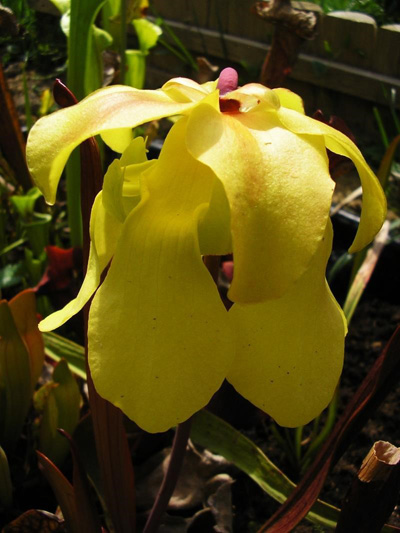
Figure 9: Pitcher of Sarracenia ‘Rubis Rare’ at the end of the growth season (left) and its bright yellow flower (right).
Sarracenia ‘Dantadelle’
Submitted: 28 April 2015
I made this hybrid between Sarracenia ‘Rubis Rare’ × mitchelliana in 2008, but I didn’t take care of the seedlings until 2013. Indeed, one was larger than all the others, which increased my interest in this crossing. I transplanted it to a large pot and, the year after, it was showing all its characteristics.
The size of the pitchers and the lids are amazingly huge and the plant produces a lot of traps that sometimes fall down under their own weight. At first, pitchers are heavily veined and well colored, but after some weeks they become entirely red (Figs. 10 & 11). The pure yellow flower appears during spring (Fig. 11) and might be shorter than the pitchers. Sarracenia ‘Dantadelle’ produces a lot of sweet nectar and grows fast from very early spring until very late summer.
I have selected this particular plant because it was clearly bigger and different from the other seedlings of the same breeding. I gave it the name “Dantadelle” because of an old bet with friends during my bachelor’s degree; I promised them that I will give my first interesting hybrid this name. This cultivar should be reproduced only by vegetative means to ensure that its unique characteristics are maintained.
— Arthur Sanguet • 73000 Chambéry • France • arthur.sanguet@gmail.com
 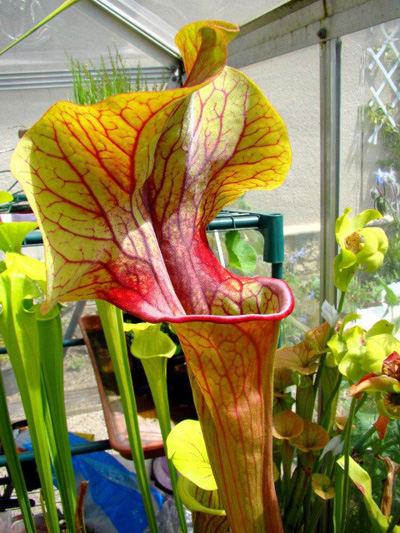
Figure 10: Fresh new pitcher of Sarracenia ‘Dantadelle’ showing green brownish coloration (left) and the particular shape and impressive size of the lid (right).
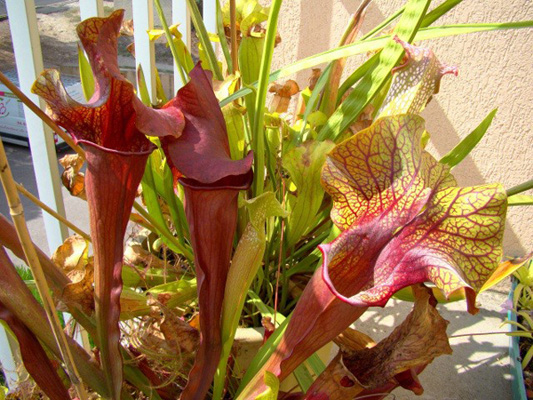 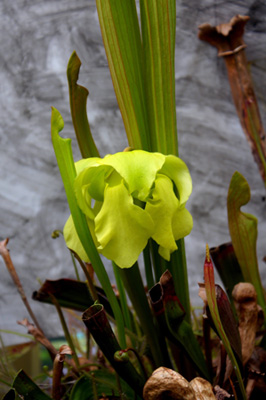
Figure 11: Three pitchers of Sarracenia ‘Dantadelle’ showing the huge size of the plant, the red coloration of older pitchers (left and middle), and the heavily veined new pitcher (right); and its yellow flower.
|

